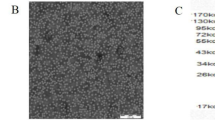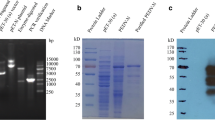Abstract
This study described the production, characterization, and application of monoclonal antibodies (mAbs) against porcine circovirus type 2 (PCV2). Twelve stable hybridomas were produced by immunization with purified PCV2a/LG strain and characterized by immunoperoxidase monolayer assay (IPMA), Western blotting, and neutralization assays. All mAbs could react with the PCV2 Cap protein and neutralize PCV2a/LG strain. One of them, mAb 3A5, reacted to all PCV2 strains from PCV2a, PCV2b, and PCV2d and it could be applied to detect PCV2 antigen and antibodies. It was shown that the mAb 3A5 could be used to locate PCV2 antigen in PK15 cells and the inguinal lymph nodes of PCV2b/YJ stain-infected piglets. Furthermore, this mAb could immunoprecipitate the Cap protein in PCV2-infected PK15 cells. Meanwhile, a capture ELISA based on mAb 3A5 was developed and used to specifically test PCV2 antigen from cultures; a linear relationship was observed between the optical density at 405 nm of the ELISA and viral titers (200–12,800 TCID50/mL), with a correlation coefficient of 0.9999. Finally, a competitive ELISA based on mAb 3A5 was developed to specifically detect antibodies in PCV2-infected and immunized pigs, and its sensitivity was higher than that of the blocking ELISA. This study suggested that the mAb 3A5 could be used in several convenient and efficient methods for PCV2 clinical and pathological studies, as well as surveillance in pigs and seroconversion monitoring in the vaccinated pigs.




Similar content being viewed by others
References
Allan GM, McNeilly F, Kennedy S, Daft B, Clarke EG, Ellis JA, Haines DM, Meehan BM, Adair BM (1998) Isolation of porcine circovirus-like viruses from pigs with a wasting disease in the USA and Europe. J Vet Diagn Investig 10(1):3–10
Beach NM, Meng XJ (2012) Efficacy and future prospects of commercially available and experimental vaccines against porcine circovirus type 2 (PCV2). Virus Res 164(1-2):33–42
Chae C (2005) A review of porcine circovirus 2-associated syndromes and diseases. Vet J 169(3):326–336
Choi C, Chae C (2001) Colocalization of porcine reproductive and respiratory syndrome virus and porcine circovirus 2 in porcine dermatitis and nephrology syndrome by double-labeling technique. Vet Pathol 38(4):436–441
Cortey M, Pileri E, Sibila M, Pujols J, Balasch M, Plana J, Segales J (2011) Genotypic shift of porcine circovirus type 2 from PCV-2a to PCV-2b in Spain from 1985 to 2008. Vet J 187(3):363–368
Du W, Wang Y, Huang L, Wei Y, Chen D, Sun J, Wu H, Feng L, Liu C (2016) Characterization of monoclonal antibodies that recognize the amino- and carboxy-terminal epitopes of the pseudorabies virus UL42 protein. Appl Microbiol Biotechnol 100(1):181–192
Dupont K, Nielsen EO, Baekbo P, Larsen LE (2008) Genomic analysis of PCV2 isolates from Danish archives and a current PMWS case-control study supports a shift in genotypes with time. Vet Microbiol 128(1-2):56–64
Fenaux M, Halbur PG, Haqshenas G, Royer R, Thomas P, Nawagitgul P, Gill M, Toth TE, Meng XJ (2002) Cloned genomic DNA of type 2 porcine circovirus is infectious when injected directly into the liver and lymph nodes of pigs: characterization of clinical disease, virus distribution, and pathologic lesions. J Virol 76(2):541–551
Fort M, Olvera A, Sibila M, Segales J, Mateu E (2007) Detection of neutralizing antibodies in postweaning multisystemic wasting syndrome (PMWS)-affected and non-PMWS-affected pigs. Vet Microbiol 125(3-4):244–255
Grau-Roma L, Hjulsager CK, Sibila M, Kristensen CS, Lopez-Soria S, Enoe C, Casal J, Botner A, Nofrarias M, Bille-Hansen V, Fraile L, Baekbo P, Segales J, Larsen LE (2009) Infection, excretion and seroconversion dynamics of porcine circovirus type 2 (PCV2) in pigs from post-weaning multisystemic wasting syndrome (PMWS) affected farms in Spain and Denmark. Vet Microbiol 135(3-4):272–282
Guo LJ, Lu YH, Wei YW, Huang LP, Liu CM (2010) Porcine circovirus type 2 (PCV2): genetic variation and newly emerging genotypes in China. Virol J 7:273
Guo LJ, Fu YJ, Huang LP, Wang YP, Wei YW, Wu HL, Liu CM (2015) A commercial PCV2a-based vaccine is effective in protection from experimental challenge of PCV2 mutant with two amino acids elongation in capsid protein. Vaccine 33(31):3752–3757
Hamel AL, Lin LL, Nayar GP (1998) Nucleotide sequence of porcine circovirus associated with postweaning multisystemic wasting syndrome in pigs. J Virol 72(6):5262–5267
He J, Cao J, Zhou N, Jin Y, Wu J, Zhou J (2013) Identification and functional analysis of the novel ORF4 protein encoded by porcine circovirus type 2. J Virol 87(3):1420–1429
Huang L, Lu Y, Wei Y, Guo L, Liu C (2011a) Development of a blocking ELISA for detection of serum neutralizing antibodies against porcine circovirus type 2. J Virol Methods 171(1):26–33
Huang L, Lu Y, Wei Y, Guo L, Wu H, Zhang F, Fu Y, Liu C (2011b) Construction and biological characterisation of recombinant porcine circovirus type 2 expressing the V5 epitope tag. Virus Res 161(2):115–123
Huang LP, Lu YH, Wei YW, Guo LJ, Liu CM (2011c) Identification of one critical amino acid that determines a conformational neutralizing epitope in the capsid protein of porcine circovirus type 2. BMC Microbiol 11:188
Huang L, Lu Y, Wei Y, Guo L, Liu C (2012) Identification of three new type-specific antigen epitopes in the capsid protein of porcine circovirus type 1. Arch Virol 157(7):1339–1344
Huang L, Van Renne N, Liu C, Nauwynck HJ (2015) A sequence of basic residues in the porcine circovirus type 2 capsid protein is crucial for its co-expression and co-localization with the replication protein. J Gen Virol 96(12):3566–3576
Huang L, Wang Y, Wei Y, Chen D, Liu D, Du W, Xia D, Wu H, Feng L, Liu C (2016) Capsid proteins from PCV2a genotype confer greater protection against a PCV2b strain than those from PCV2b genotype in pigs: evidence for PCV2b strains becoming more predominant than PCV2a strains from 2000 to 2010s. Appl Microbiol Biotechnol 100(13):5933–5943
Khayat R, Brunn N, Speir JA, Hardham JM, Ankenbauer RG, Schneemann A, Johnson JE (2011) The 2.3-angstrom structure of porcine circovirus 2. J Virol 85(15):7856–7862
Kim J, Chung HK, Chae C (2003) Association of porcine circovirus 2 with porcine respiratory disease complex. Vet J 166(3):251–256
Lefebvre DJ, Costers S, Van Doorsselaere J, Misinzo G, Delputte PL, Nauwynck HJ (2008) Antigenic differences among porcine circovirus type 2 strains, as demonstrated by the use of monoclonal antibodies. J Gen Virol 89(Pt 1:177–187
Lekcharoensuk P, Morozov I, Paul PS, Thangthumniyom N, Wajjawalku W, Meng XJ (2004) Epitope mapping of the major capsid protein of type 2 porcine circovirus (PCV2) by using chimeric PCV1 and PCV2. J Virol 78(15):8135–8145
Liu C, Ihara T, Nunoya T, Ueda S (2004) Development of an ELISA based on the baculovirus-expressed capsid protein of porcine circovirus type 2 as antigen. J Vet Med Sci 66(3):237–242
Liu J, Chen I, Kwang J (2005) Characterization of a previously unidentified viral protein in porcine circovirus type 2-infected cells and its role in virus-induced apoptosis. J Virol 79(13):8262–8274
Liu J, Chen I, Du Q, Chua H, Kwang J (2006) The ORF3 protein of porcine circovirus type 2 is involved in viral pathogenesis in vivo. J Virol 80(10):5065–5073
Liu J, Huang L, Wei Y, Tang Q, Liu D, Wang Y, Li S, Guo L, Wu H, Liu C (2013) Amino acid mutations in the capsid protein produce novel porcine circovirus type 2 neutralizing epitopes. Vet Microbiol 165(3-4):260–267
Lv Q, Guo K, Xu H, Wang T, Zhang Y (2015) Identification of putative ORF5 protein of porcine circovirus type 2 and functional analysis of GFP-fused ORF5 protein. PLoS One 10:e0127859
Mankertz J, Buhk HJ, Blaess G, Mankertz A (1998) Transcription analysis of porcine circovirus (PCV). Virus Genes 16(3):267–276
Mankertz A, Caliskan R, Hattermann K, Hillenbrand B, Kurzendoerfer P, Mueller B, Schmitt C, Steinfeldt T, Finsterbusch T (2004) Molecular biology of porcine circovirus: analyses of gene expression and viral replication. Vet Microbiol 98(2):81–88
Martelli P, Ferrari L, Morganti M, De Angelis E, Bonilauri P, Guazzetti S, Caleffi A, Borghetti P (2011) One dose of a porcine circovirus 2 subunit vaccine induces humoral and cell-mediated immunity and protects against porcine circovirus-associated disease under field conditions. Vet Microbiol 149(3-4):339–351
McNeilly F, McNair I, O’Connor M, Brockbank S, Gilpin D, Lasagna C, Boriosi G, Meehan B, Ellis J, Krakowka S, Allan GM (2002) Evaluation of a porcine circovirus type 2-specific antigen-capture enzyme-linked immunosorbent assay for the diagnosis of postweaning multisystemic wasting syndrome in pigs: comparison with virus isolation, immunohistochemistry, and the polymerase chain reaction. J Vet Diagn Investig 14(2):106–112
Meehan BM, McNeilly F, Todd D, Kennedy S, Jewhurst VA, Ellis JA, Hassard LE, Clark EG, Haines DM, Allan GM (1998) Characterization of novel circovirus DNAs associated with wasting syndromes in pigs. J Gen Virol 79 ( Pt 9:2171–2179
Misinzo G, Delputte PL, Meerts P, Lefebvre DJ, Nauwynck HJ (2006) Porcine circovirus 2 uses heparan sulfate and chondroitin sulfate B glycosaminoglycans as receptors for its attachment to host cells. J Virol 80(7):3487–3494
Nauwynck HJ, Sanchez R, Meerts P, Lefebvre DJ, Saha D, Huang L, Misinzo G (2012) Cell tropism and entry of porcine circovirus 2. Virus Res 164(1-2):43–45
Nawagitgul P, Morozov I, Bolin SR, Harms PA, Sorden SD, Paul PS (2000) Open reading frame 2 of porcine circovirus type 2 encodes a major capsid protein. J Gen Virol 81(Pt 9):2281–2287
Nawagitgul P, Harms PA, Morozov I, Thacker BJ, Sorden SD, Lekcharoensuk C, Paul PS (2002) Modified indirect porcine circovirus (PCV) type 2-based and recombinant capsid protein (ORF2)-based enzyme-linked immunosorbent assays for detection of antibodies to PCV. Clin Diagn Lab Immunol 9(1):33–40
Pileri E, Cortey M, Rodriguez F, Sibila M, Fraile L, Segales J (2014) Comparison of the immunoperoxidase monolayer assay and three commercial ELISAs for detection of antibodies against porcine circovirus type 2. Vet J 201(3):429–432
Saha D, Lefebvre DJ, Van Doorsselaere J, Atanasova K, Barbe F, Geldhof M, Karniychuk UU, Nauwynck HJ (2010) Pathologic and virologic findings in mid-gestational porcine foetuses after experimental inoculation with PCV2a or PCV2b. Vet Microbiol 145(1-2):62–68
Saha D, Huang L, Bussalleu E, Lefebvre DJ, Fort M, Van Doorsselaere J, Nauwynck HJ (2012a) Antigenic subtyping and epitopes’ competition analysis of porcine circovirus type 2 using monoclonal antibodies. Vet Microbiol 157(1-2):13–22
Saha D, Lefebvre DJ, Ooms K, Huang L, Delputte PL, Van Doorsselaere J, Nauwynck HJ (2012b) Single amino acid mutations in the capsid switch the neutralization phenotype of porcine circovirus 2. J Gen Virol 93(Pt 7):1548–1555
Segalés J (2012) Porcine circovirus type 2 (PCV2) infections: clinical signs, pathology and laboratory diagnosis. Virus Res 164(1-2):10–19
Walker IW, Konoby CA, Jewhurst VA, McNair I, McNeilly F, Meehan BM, Cottrell TS, Ellis JA, Allan GM (2000) Development and application of a competitive enzyme-linked immunosorbent assay for the detection of serum antibodies to porcine circovirus type 2. J Vet Diagn Investig 12(5):400–405
Xiao CT, Halbur PG, Opriessnig T (2015) Global molecular genetic analysis of porcine circovirus type 2 (PCV2) sequences confirms the presence of four main PCV2 genotypes and reveals a rapid increase of PCV2d. J Gen Virol 96(Pt 7:1830–1841
Funding
This study was supported by the National Natural Science Foundation of China (grant no. 31873012), the Heilongjiang Province Natural Science Foundation of China (grant no. C2015064), and the National Key Research and Development Programs (grant no. 2017YFD0500903 and 2017YFD0501603).
Author information
Authors and Affiliations
Corresponding author
Ethics declarations
Conflict of interest
The authors declare that they have no competing interests.
Ethical statement
The experimental protocol was approved by the Animal Care and Use Committee of the Harbin Veterinary Research Institute (HVRI), and it was performed in accordance with animal care and ethics guidelines. The animal ethics committee approval number is Heilongjiang-SYXK-2017-009.
Additional information
Publisher’s note
Springer Nature remains neutral with regard to jurisdictional claims in published maps and institutional affiliations.
Rights and permissions
About this article
Cite this article
Huang, L., Wei, Y., Xia, D. et al. A broad spectrum monoclonal antibody against porcine circovirus type 2 for antigen and antibody detection. Appl Microbiol Biotechnol 103, 3453–3464 (2019). https://doi.org/10.1007/s00253-019-09715-0
Received:
Revised:
Accepted:
Published:
Issue Date:
DOI: https://doi.org/10.1007/s00253-019-09715-0




